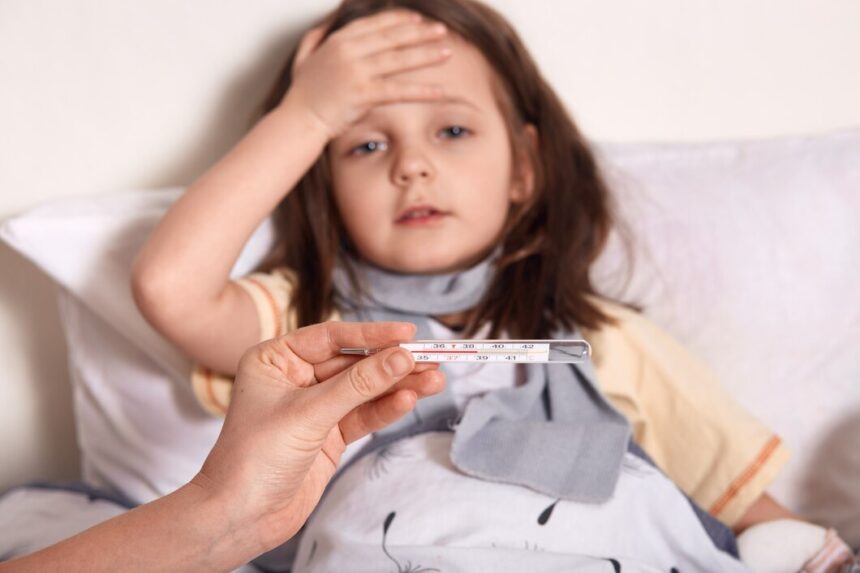Scarlet fever, also known as scarlatina, is a bacterial infection caused by group A Streptococcus bacteria. It primarily affects children, although it can occur in people of all ages. Scarlet fever is characterized by a distinctive rash, along with other symptoms that can range from mild to severe. Recognizing the early signs and symptoms of scarlet fever is crucial for prompt diagnosis and treatment. Here are the key indicators parents should watch out for:
1. Sore Throat
Scarlet fever often begins with a sore throat, which can be mild initially but progressively worsens over time. The sore throat is usually accompanied by pain, difficulty swallowing, and redness or inflammation of the throat and tonsils.
2. Fever
A fever is a common symptom of scarlet fever and is usually present at the onset of the illness. The fever may be moderate to high-grade, with temperatures typically ranging from 101°F (38.3°C) to 104°F (40°C). Fever-reducing medications may provide temporary relief but do not address the underlying infection.
3. Red, Sandpaper-Like Rash
One of the hallmark signs of scarlet fever is a distinctive rash that typically appears 1 to 2 days after the onset of symptoms. The rash is characterized by small, red, raised bumps that feel like sandpaper to the touch. It usually starts on the neck and chest before spreading to other parts of the body, including the abdomen, back, and extremities.
4. Flushed Face
Children with scarlet fever often have a flushed or reddened face, particularly around the cheeks. The facial flushing is typically accompanied by a pale area around the mouth, giving the appearance of a “slapped cheek” appearance.
5. Strawberry Tongue
Another characteristic feature of scarlet fever is a “strawberry tongue,” where the tongue appears red and swollen with prominent taste buds. The tongue may initially have a white coating, which eventually peels away, leaving the red, bumpy surface resembling a strawberry.
6. Swollen Glands
Enlarged lymph nodes, or swollen glands, are common in children with scarlet fever. The lymph nodes in the neck, under the jaw, and behind the ears may become tender and palpable due to the body’s immune response to the bacterial infection.
7. Nausea and Vomiting
Some children with scarlet fever may experience gastrointestinal symptoms such as nausea, vomiting, or abdominal pain. These symptoms can contribute to dehydration, especially if accompanied by fever and decreased fluid intake.
8. General Malaise
Children with scarlet fever may feel generally unwell and fatigued, with reduced energy levels and activity levels. They may appear irritable, lethargic, or reluctant to engage in usual activities due to the discomfort associated with the infection.
9. Chills and Body Aches
Chills and body aches are common accompanying symptoms of scarlet fever, particularly during the early stages of the illness. Children may complain of muscle aches, joint pain, or overall discomfort in addition to other symptoms.
10. Difficulty Swallowing
As the sore throat worsens, children may experience difficulty swallowing, particularly when eating or drinking. Swollen tonsils and throat inflammation can make swallowing painful and uncomfortable.
When to Seek Medical Attention
Parents should seek medical attention if their child exhibits signs or symptoms of scarlet fever, particularly if accompanied by high fever, difficulty breathing, or signs of dehydration. Prompt diagnosis and treatment with antibiotics are essential for managing scarlet fever and preventing complications such as rheumatic fever or kidney inflammation.
Scarlet fever is a contagious bacterial infection that primarily affects children, causing symptoms such as sore throat, fever, rash, and other accompanying symptoms. Recognizing the early signs and symptoms of scarlet fever is crucial for prompt diagnosis and treatment to alleviate discomfort and prevent complications. Parents should monitor their children closely and seek medical attention if they suspect scarlet fever or if symptoms worsen or persist despite home care measures. With timely intervention, scarlet fever can be effectively managed, allowing children to recover fully and resume normal activities.










